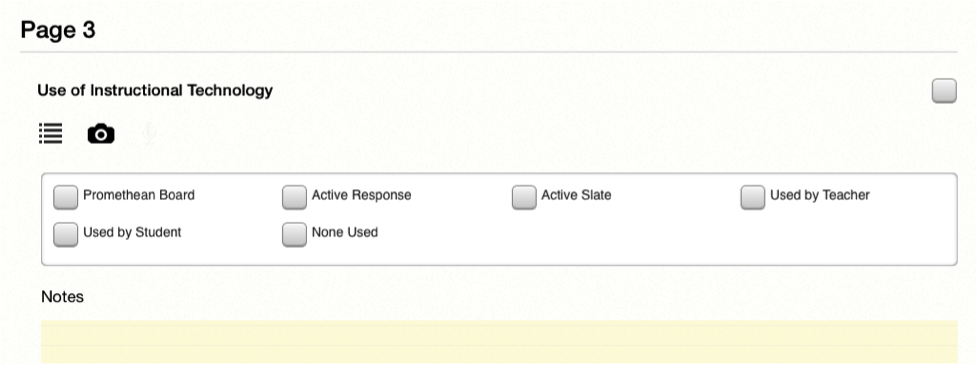It seems that over the years I have found myself referencing the benefit of classroom walk-throughs on many occasions as I speak about the things we do in our building. Just recently I had the opportunity to speak with two members of my faculty and as the conversation progressed I noticed that our walk-through procedures kept coming up.
I have two faculty members that are currently completing their Educational Specialists degree in instructional technology. A requirement of their class is to interview the principal regarding the implementation, use, and monitoring of instructional technology. The interview consisted of 10 questions that focused on my opinion of Technology Innovation and Training.
The following four questions were listed among the 10 interview questions I was asked by my faculty members. I selected these four questions to list here because the walk-through experience directly impacts our implementation and monitoring of instructional technology.
You will notice that immediately following each question are the initials “PSC” and a number. This is the abbreviation for the Professional Standards Commission Instructional Technology Standards. The Professional Standards Commission is the governing body for teacher licensure in my state and these abbreviations represent alignment of the specific question listed below with the PSC adopted Instructional Technology Standards for our state.
Q- How are professional learning needs identified in your school? Are they data driven? (PSC 5.1)
Response- Professional learning needs are primarily identified through our walk-through process. The benefits of visiting so many class rooms are that we have real-time knowledge of how our students and teachers are performing. Our walk-through process affords us multiple opportunities to identify deficiencies among individuals and/or groups of students and/or teachers that may need specific supports in the various instructional areas. Our continuous opportunities to be involved in the instructional aspects of our school through the walk-through process afford opportunities for us to intervene early before issues become unmanageable. Our eWalk procedures result in real-time data being collected on the class room experiences of our students and teachers. This allows our decisions to be data driven based upon actual observations of class room practice.
Q- What type of follow-up support is provided AFTER a professional learning session in order to help teachers master new strategies and content and integrate them into their class room practice? Is the professional learning aligned to the school improvement goals? (PSC 1.2)
Response- Our goal is to average at least 50 walk-throughs each week among the five administrators in our building. This volume of class room visits allows us to critically monitor the implementation of professional learning initiatives. We specifically look for implementation practices that are aligned to the specific professional learning. Two years prior our school system invested a substantial amount of SPLOST dollars into supplying our teachers with instructional technology. To monitor the implementation and use of instructional technology practices into the class room we incorporated an element into our class room walk-through template that focused specifically on the implementation and use of instructional technology. eWalk allows us opportunities to customize our templates to monitor specific instructional initiatives. The items listed in our walk-through template are directly aligned to our school improvement plan.

Use of Instructional Technology Element used for daily walk-through visits
Q- What are the incentives for teachers to participate in professional learning and to improve their practice? (PSC 1.3, PSC 1.4)
Response- I think the most appropriate manner in which to answer this question is to provide a few examples. We have a Math teacher who is very excited about instructional technology and goes to great lengths to provide innovative teaching strategies for his students through his use of instructional technology. He had an idea about incorporating the use of an iPad into his teaching. We bought an iPad for him to explore while teaching Math and it has been a huge hit. We have since purchased iPads for additional Math teachers to use for instruction. We have also tapped teachers in all subject areas who are technology experts to conduct workshops and share with other teachers the great things they are doing in the class room with instructional technology. We make every attempt to recognize our most effective teachers and provide them with the praise and admiration they deserve. All of this is a direct result of our walk-through visits and what we observe in the class room.
Q- How is the impact of professional learning on teacher practice and student learning evaluated? In other words, how do you know whether the professional learning is translated into practice? How do you know if the professional learning improves student learning? (PSC 5.3)
Response- I answered this question much like I answered the question above regarding follow-up support for professional learning. We are in class rooms so often that monitoring how professional learning is aligned with actual teacher practice in the class room is not difficult. We make a point to look for practical applications of professional learning in the everyday teaching practices of our faculty and staff. Since we require our paraprofessionals to attend the same professional learning as our teachers we want to see our support staff attempting those same professional learning initiatives with our students. We wish for all adults in our class rooms to improve their teaching practices through the professional learning opportunities we provide. For that reason we also conduct walk-throughs on paraprofessionals. We will even conduct walk-throughs on administrators when they are teaching. No one is excused from our walk-through process. eWalk makes us all better educators.
If you find this information useful or if I can assist you with other educational endeavors please leave a comment or contact me directly at sean.kelly@douglas.k12.ga.us
